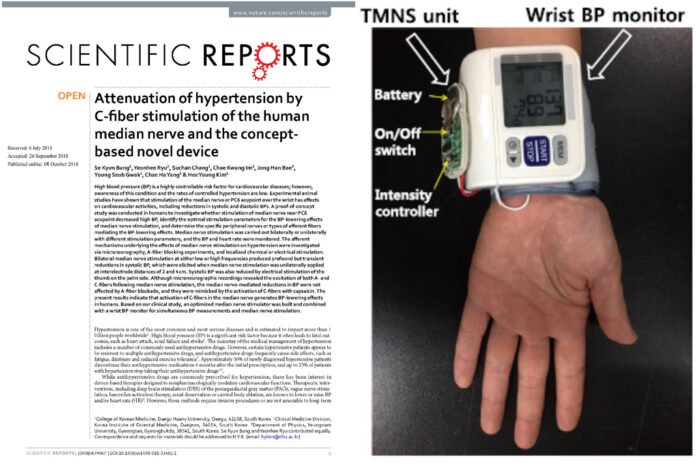
By Namwook Cho, L.Ac.
Hypertension is a common and serious disease which impact more than 1 billion people worldwide. Moreover, high blood pressure is a significant risk factor for heart attack, renal failure and stroke.
Recently, a group of researchers found that stimulation of the median nerve, which is nearby acupuncture point PC6, can reduce blood pressure for hypertensive patients.
Attenuation of hypertension by C-fiber stimulation of the human median nerve and the concept based novel device
The coauthors of this paper, Se kyung Bang College of Korean Medicine Daegu, South Korean and Yeon Hee Ryu, Clinical Medicine Division, Korea Institute of Oriental medicine Daejeon, South Korea, explain that certain hypertensive patients appear to be resistant to multiple antihypertensive medicines due to side effects such as fatigue, dizziness and reduced exercise tolerance. Furthermore, “Approximately 50% of newly diagnosed hypertensive patients discontinue their antihypertensive medications 6 months after the initial prescription, and up to 25% of patients stop taking the medicine.” Alternatively, the researchers look towards acupuncture for treatment of hypertension.
The study was conducted in 11 people to investigate whether electric stimulation of median nerve near PC6 decreases blood pressure. All 11 people were diagnosed with hypertension and have not taken any hypertensive medicine before.
Experiments were performed with varying frequencies of transcutaneous median nerve stimulation (TMNS) on hypertension bilaterally or unilaterally. TMNS was applied bilaterally for 30 minutes at frequencies of 3, 10, 30 or 300 Hz to study the effect of TMNS on hypertension and determine the optimal stimulation frequency. Median nerve stimulation was unilaterally applied at interelectrode distances of 2, 4, and 6 cm.
The research team used a prototype median nerve stimulator combined with a wrist blood pressure monitor for simultaneous blood pressure measurement and median nerve stimulation.
Results of the study proved that acupuncture needle insertion on PC6 with an electrical stimulation an interelectrode distance of 4cm, and a frequency of 10 Hz was most effective for reducing systolic pressure. The research team treated hypertension patients with the same method for 1 month, once a week. On the 4th session, they measured blood pressure and confirmed that the average 15 mmHg in systolic was reduced for 14 weeks.
This research was published online at the Scientific Reports, “Attenuation of hypertension by C-fiber stimulation of the human median nerve and the concept based novel device” recently (DOI: https://doi.org/10.1038/s41598-018-33402-1).


































